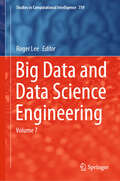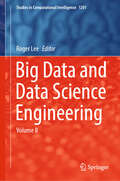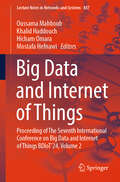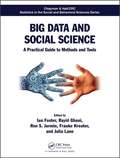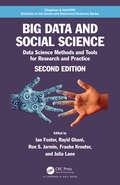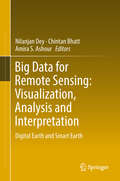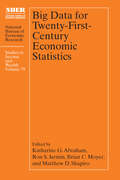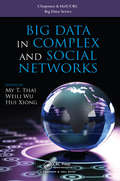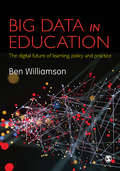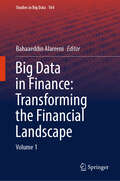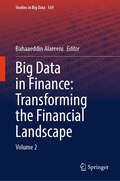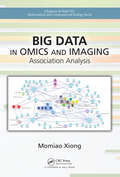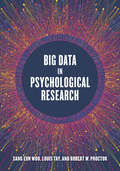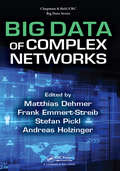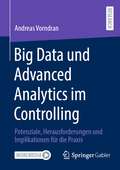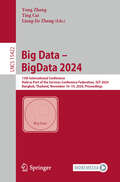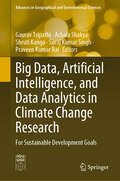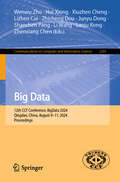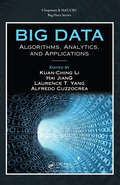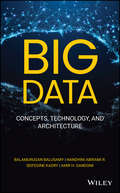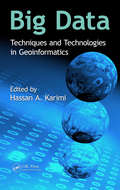- Table View
- List View
Big Data and Data Science Engineering: Volume 7 (Studies in Computational Intelligence #759)
by Roger LeeThis book reports state-of-the-art results in Big Data and Data Science Engineering in both printed and electronic form. Studies in Computation Intelligence (SCI) has grown into the most comprehensive computational intelligence research forum available in the world. This book publishes original papers on both theory and practice that address foundations, state-of-the-art problems and solutions, and crucial challenges.
Big Data and Data Science Engineering: Volume 8 (Studies in Computational Intelligence #1201)
by Roger LeeThis book reports state-of-the-art results in big data and data science engineering in both printed and electronic forms. Studies in computation intelligence (SCI) has grown into the most comprehensive computational intelligence research forum available in the world. This book publishes original papers on both theory and practice that address foundations, state-of-the-art problems and solutions, and crucial challenges.
Big Data and Differential Privacy: Analysis Strategies for Railway Track Engineering
by Nii O. Attoh-OkineA comprehensive introduction to the theory and practice of contemporary data science analysis for railway track engineering Featuring a practical introduction to state-of-the-art data analysis for railway track engineering, Big Data and Differential Privacy: Analysis Strategies for Railway Track Engineering addresses common issues with the implementation of big data applications while exploring the limitations, advantages, and disadvantages of more conventional methods. In addition, the book provides a unifying approach to analyzing large volumes of data in railway track engineering using an array of proven methods and software technologies. Dr. Attoh-Okine considers some of today’s most notable applications and implementations and highlights when a particular method or algorithm is most appropriate. Throughout, the book presents numerous real-world examples to illustrate the latest railway engineering big data applications of predictive analytics, such as the Union Pacific Railroad’s use of big data to reduce train derailments, increase the velocity of shipments, and reduce emissions. In addition to providing an overview of the latest software tools used to analyze the large amount of data obtained by railways, Big Data and Differential Privacy: Analysis Strategies for Railway Track Engineering: • Features a unified framework for handling large volumes of data in railway track engineering using predictive analytics, machine learning, and data mining • Explores issues of big data and differential privacy and discusses the various advantages and disadvantages of more conventional data analysis techniques • Implements big data applications while addressing common issues in railway track maintenance • Explores the advantages and pitfalls of data analysis software such as R and Spark, as well as the Apache™ Hadoop® data collection database and its popular implementation MapReduce Big Data and Differential Privacy is a valuable resource for researchers and professionals in transportation science, railway track engineering, design engineering, operations research, and railway planning and management. The book is also appropriate for graduate courses on data analysis and data mining, transportation science, operations research, and infrastructure management. NII ATTOH-OKINE, PhD, PE is Professor in the Department of Civil and Environmental Engineering at the University of Delaware. The author of over 70 journal articles, his main areas of research include big data and data science; computational intelligence; graphical models and belief functions; civil infrastructure systems; image and signal processing; resilience engineering; and railway track analysis. Dr. Attoh-Okine has edited five books in the areas of computational intelligence, infrastructure systems and has served as an Associate Editor of various ASCE and IEEE journals.
Big Data and Internet of Things: Proceeding of The Seventh International Conference on Big Data and Internet of Things BDIoT'24, Volume 2 (Lecture Notes in Networks and Systems #887)
by Oussama Mahboub Khalid Haddouch Hicham Omara Mostafa Hefnawi"Big Data and Internet of Things" is the latest volume in the renowned Lecture Notes in Networks and Systems series. This book compiles the latest research presented at the Seventh International Conference on Big Data and Internet of Things (BDIoT'24), showcasing innovative solutions, emerging trends, and practical applications in the fields of big data and IoT. An essential read for researchers, professionals, and students looking to stay ahead in the rapidly evolving world of technology. The series contains proceedings and edited volumes in systems and networks, spanning the areas of Cyber-Physical Systems, Autonomous Systems, Sensor Networks, Control Systems, Energy Systems, Automotive Systems. Biological Systems, Vehicular Networking and Connected Vehicles, Aerospace Systems Automation, Manufacturing, Smart Grids. Nonlinear Systems, Power Systems, Robotics, Social Systems, Economic Systems and other. The series covers the theory, applications, and perspectives on the state of the art and future developments relevant to systems and networks, decision making, control, complex processes and related areas, as embedded in the fields of interdisciplinary and applied sciences, engineering, computer science, physics, economics, social, and life sciences, as well as the paradigms and methodologies behind them.
Big Data and Social Science: A Practical Guide to Methods and Tools
by Frauke Kreuter Julia Lane Ian Foster Rayid Ghani Ron S. JarminBig Data and Social Science: A Practical Guide to Methods and Tools shows how to apply data science to real-world problems in both research and the practice. The book provides practical guidance on combining methods and tools from computer science, statistics, and social science. This concrete approach is illustrated throughout using an important national problem, the quantitative study of innovation. The text draws on the expertise of prominent leaders in statistics, the social sciences, data science, and computer science to teach students how to use modern social science research principles as well as the best analytical and computational tools. It uses a real-world challenge to introduce how these tools are used to identify and capture appropriate data, apply data science models and tools to that data, and recognize and respond to data errors and limitations.
Big Data and Social Science: Data Science Methods and Tools for Research and Practice (Chapman & Hall/CRC Statistics in the Social and Behavioral Sciences)
by Ian Foster, Rayid Ghani, Ron S. Jarmin, Frauke Kreuter and Julia LaneBig Data and Social Science: Data Science Methods and Tools for Research and Practice, Second Edition shows how to apply data science to real-world problems, covering all stages of a data-intensive social science or policy project. Prominent leaders in the social sciences, statistics, and computer science as well as the field of data science provide a unique perspective on how to apply modern social science research principles and current analytical and computational tools. The text teaches you how to identify and collect appropriate data, apply data science methods and tools to the data, and recognize and respond to data errors, biases, and limitations. Features: Takes an accessible, hands-on approach to handling new types of data in the social sciences Presents the key data science tools in a non-intimidating way to both social and data scientists while keeping the focus on research questions and purposes Illustrates social science and data science principles through real-world problems Links computer science concepts to practical social science research Promotes good scientific practice Provides freely available workbooks with data, code, and practical programming exercises, through Binder and GitHub New to the Second Edition: Increased use of examples from different areas of social sciences New chapter on dealing with Bias and Fairness in Machine Learning models Expanded chapters focusing on Machine Learning and Text Analysis Revamped hands-on Jupyter notebooks to reinforce concepts covered in each chapter This classroom-tested book fills a major gap in graduate- and professional-level data science and social science education. It can be used to train a new generation of social data scientists to tackle real-world problems and improve the skills and competencies of applied social scientists and public policy practitioners. It empowers you to use the massive and rapidly growing amounts of available data to interpret economic and social activities in a scientific and rigorous manner.
Big Data for Remote Sensing: Digital Earth And Smart Earth
by Nilanjan Dey Chintan Bhatt Amira S. AshourThis book thoroughly covers the remote sensing visualization and analysis techniques based on computational imaging and vision in Earth science. Remote sensing is considered a significant information source for monitoring and mapping natural and man-made land through the development of sensor resolutions that committed different Earth observation platforms. The book includes related topics for the different systems, models, and approaches used in the visualization of remote sensing images. It offers flexible and sophisticated solutions for removing uncertainty from the satellite data. It introduces real time big data analytics to derive intelligence systems in enterprise earth science applications. Furthermore, the book integrates statistical concepts with computer-based geographic information systems (GIS). It focuses on image processing techniques for observing data together with uncertainty information raised by spectral, spatial, and positional accuracy of GPS data. The book addresses several advanced improvement models to guide the engineers in developing different remote sensing visualization and analysis schemes. Highlights on the advanced improvement models of the supervised/unsupervised classification algorithms, support vector machines, artificial neural networks, fuzzy logic, decision-making algorithms, and Time Series Model and Forecasting are addressed. This book guides engineers, designers, and researchers to exploit the intrinsic design remote sensing systems. The book gathers remarkable material from an international experts' panel to guide the readers during the development of earth big data analytics and their challenges.
Big Data for Twenty-First-Century Economic Statistics (National Bureau of Economic Research Studies in Income and Wealth #79)
by Katharine G. Abraham, Ron S. Jarmin, Brian C. Moyer, and Matthew D. ShapiroThe papers in this volume analyze the deployment of Big Data to solve both existing and novel challenges in economic measurement. The existing infrastructure for the production of key economic statistics relies heavily on data collected through sample surveys and periodic censuses, together with administrative records generated in connection with tax administration. The increasing difficulty of obtaining survey and census responses threatens the viability of existing data collection approaches. The growing availability of new sources of Big Data—such as scanner data on purchases, credit card transaction records, payroll information, and prices of various goods scraped from the websites of online sellers—has changed the data landscape. These new sources of data hold the promise of allowing the statistical agencies to produce more accurate, more disaggregated, and more timely economic data to meet the needs of policymakers and other data users. This volume documents progress made toward that goal and the challenges to be overcome to realize the full potential of Big Data in the production of economic statistics. It describes the deployment of Big Data to solve both existing and novel challenges in economic measurement, and it will be of interest to statistical agency staff, academic researchers, and serious users of economic statistics.
Big Data for Twenty-First-Century Economic Statistics (National Bureau of Economic Research Studies in Income and Wealth #79)
by Katharine G. Abraham, Ron S. Jarmin, Brian C. Moyer, and Matthew D. ShapiroThe papers in this volume analyze the deployment of Big Data to solve both existing and novel challenges in economic measurement. The existing infrastructure for the production of key economic statistics relies heavily on data collected through sample surveys and periodic censuses, together with administrative records generated in connection with tax administration. The increasing difficulty of obtaining survey and census responses threatens the viability of existing data collection approaches. The growing availability of new sources of Big Data—such as scanner data on purchases, credit card transaction records, payroll information, and prices of various goods scraped from the websites of online sellers—has changed the data landscape. These new sources of data hold the promise of allowing the statistical agencies to produce more accurate, more disaggregated, and more timely economic data to meet the needs of policymakers and other data users. This volume documents progress made toward that goal and the challenges to be overcome to realize the full potential of Big Data in the production of economic statistics. It describes the deployment of Big Data to solve both existing and novel challenges in economic measurement, and it will be of interest to statistical agency staff, academic researchers, and serious users of economic statistics.
Big Data in Complex and Social Networks (Chapman & Hall/CRC Big Data Series)
by My T. Thai, Weili Wu, Hui XiongThis book presents recent developments on the theoretical, algorithmic, and application aspects of Big Data in Complex and Social Networks. The book consists of four parts, covering a wide range of topics. The first part of the book focuses on data storage and data processing. It explores how the efficient storage of data can fundamentally support intensive data access and queries, which enables sophisticated analysis. It also looks at how data processing and visualization help to communicate information clearly and efficiently. The second part of the book is devoted to the extraction of essential information and the prediction of web content. The book shows how Big Data analysis can be used to understand the interests, location, and search history of users and provide more accurate predictions of User Behavior. The latter two parts of the book cover the protection of privacy and security, and emergent applications of big data and social networks. It analyzes how to model rumor diffusion, identify misinformation from massive data, and design intervention strategies. Applications of big data and social networks in multilayer networks and multiparty systems are also covered in-depth.
Big Data in Education: The digital future of learning, policy and practice
by Ben WilliamsonBig data has the power to transform education and educational research. Governments, researchers and commercial companies are only beginning to understand the potential that big data offers in informing policy ideas, contributing to the development of new educational tools and innovative ways of conducting research. This cutting-edge overview explores the current state-of-play, looking at big data and the related topic of computer code to examine the implications for education and schooling for today and the near future. Key topics include: · The role of learning analytics and educational data science in schools · A critical appreciation of code, algorithms and infrastructures · The rise of ‘cognitive classrooms’, and the practical application of computational algorithms to learning environments · Important digital research methods issues for researchers This is essential reading for anyone studying or working in today's education environment!
Big Data in Education: The digital future of learning, policy and practice
by Ben WilliamsonBig data has the power to transform education and educational research. Governments, researchers and commercial companies are only beginning to understand the potential that big data offers in informing policy ideas, contributing to the development of new educational tools and innovative ways of conducting research. This cutting-edge overview explores the current state-of-play, looking at big data and the related topic of computer code to examine the implications for education and schooling for today and the near future. Key topics include: · The role of learning analytics and educational data science in schools · A critical appreciation of code, algorithms and infrastructures · The rise of ‘cognitive classrooms’, and the practical application of computational algorithms to learning environments · Important digital research methods issues for researchers This is essential reading for anyone studying or working in today's education environment!
Big Data in Finance: Volume 1 (Studies in Big Data #164)
by Bahaaeddin AlareeniThis book offers a comprehensive exploration of how Big Data analytics is reshaping the financial world, providing crucial insights for industry professionals, scholars, and enthusiasts alike. This book delves into the expansive potential of Big Data in revolutionizing financial decision-making, risk management, and operational efficiency. It explores how advanced analytics, machine learning, and artificial intelligence are disrupting traditional financial models, empowering institutions with unparalleled insights and a competitive edge. While highlighting technological advancements, the book also addresses the challenges and ethical considerations inherent in data-driven finance. With contributions from leading experts and thought leaders, this book serves as an indispensable resource for anyone eager to understand and harness the transformative power of Big Data in finance. Embark on a journey through the dynamic convergence of finance and technology, and discover how Big Data is shaping the future of the financial landscape, one data point at a time.
Big Data in Finance: Volume 2 (Studies in Big Data #169)
by Bahaaeddin AlareeniThis book uncovers the potential of machine learning, artificial intelligence, and advanced analytics to empower financial institutions to stay competitive in an ever-evolving market. In the age of digital transformation, big data is revolutionizing the financial industry, reshaping how businesses understand markets, manage risks, and make strategic decisions. "Big Data in Finance: Transforming the Financial Landscape" offers a comprehensive exploration of the cutting-edge technologies and analytics driving this change, making it an essential resource for professionals, scholars, business leaders, and enthusiasts alike. From enhancing operational efficiency to enabling more accurate forecasting, this book delves deep into how data-driven insights are transforming traditional financial models. With practical insights, real-world applications, and contributions from industry leaders, this book provides a balanced perspective on both the opportunities and challenges of data-driven finance. It addresses key ethical considerations, regulatory concerns, and future trends, offering readers a holistic understanding of the dynamic intersection of technology and finance. Discover how big data is shaping the future of finance, and gain the knowledge you need to harness its full potential. Whether you're looking to innovate, optimize, or simply stay informed, "Big Data in Finance: Transforming the Financial Landscape" is your roadmap to success in the new era of digital finance.
Big Data in Omics and Imaging: Association Analysis (Chapman & Hall/CRC Mathematical and Computational Biology)
by Momiao XiongBig Data in Omics and Imaging: Association Analysis addresses the recent development of association analysis and machine learning for both population and family genomic data in sequencing era. It is unique in that it presents both hypothesis testing and a data mining approach to holistically dissecting the genetic structure of complex traits and to designing efficient strategies for precision medicine. The general frameworks for association analysis and machine learning, developed in the text, can be applied to genomic, epigenomic and imaging data. FEATURES Bridges the gap between the traditional statistical methods and computational tools for small genetic and epigenetic data analysis and the modern advanced statistical methods for big data Provides tools for high dimensional data reduction Discusses searching algorithms for model and variable selection including randomization algorithms, Proximal methods and matrix subset selection Provides real-world examples and case studies Will have an accompanying website with R code The book is designed for graduate students and researchers in genomics, bioinformatics, and data science. It represents the paradigm shift of genetic studies of complex diseases– from shallow to deep genomic analysis, from low-dimensional to high dimensional, multivariate to functional data analysis with next-generation sequencing (NGS) data, and from homogeneous populations to heterogeneous population and pedigree data analysis. Topics covered are: advanced matrix theory, convex optimization algorithms, generalized low rank models, functional data analysis techniques, deep learning principle and machine learning methods for modern association, interaction, pathway and network analysis of rare and common variants, biomarker identification, disease risk and drug response prediction.
Big Data in Psychological Research
by Robert W. Proctor Louis Tay Sang Eun WooTechnological advances have led to an abundance of widely available data on every aspect of life today. Psychologists today have more information than ever before on human cognition, emotion, attitudes, and behavior. Big Data in Psychological Research addresses the opportunities and challenges that these data present to psychological researchers. This edited collection provides an overview of theoretical approaches to the utility and purpose of big data, approaches to research design and analysis, collection methods, applications, limitations, best practice recommendations, and key issues related to privacy, security, and ethical concerns that are essential to understand for anyone working with big data. The book also discusses potential future research directions aimed at improving the quality and interpretation of big data projects, as well as the training and evaluation of psychological science teams that conduct research using big data.
Big Data of Complex Networks (Chapman & Hall/CRC Big Data Series)
by Matthias Dehmer, Frank Emmert-Streib, Stefan Pickl and Andreas HolzingerBig Data of Complex Networks presents and explains the methods from the study of big data that can be used in analysing massive structural data sets, including both very large networks and sets of graphs. As well as applying statistical analysis techniques like sampling and bootstrapping in an interdisciplinary manner to produce novel techniques for analyzing massive amounts of data, this book also explores the possibilities offered by the special aspects such as computer memory in investigating large sets of complex networks. Intended for computer scientists, statisticians and mathematicians interested in the big data and networks, Big Data of Complex Networks is also a valuable tool for researchers in the fields of visualization, data analysis, computer vision and bioinformatics. Key features: Provides a complete discussion of both the hardware and software used to organize big data Describes a wide range of useful applications for managing big data and resultant data sets Maintains a firm focus on massive data and large networks Unveils innovative techniques to help readers handle big data Matthias Dehmer received his PhD in computer science from the Darmstadt University of Technology, Germany. Currently, he is Professor at UMIT – The Health and Life Sciences University, Austria, and the Universität der Bundeswehr München. His research interests are in graph theory, data science, complex networks, complexity, statistics and information theory. Frank Emmert-Streib received his PhD in theoretical physics from the University of Bremen, and is currently Associate professor at Tampere University of Technology, Finland. His research interests are in the field of computational biology, machine learning and network medicine. Stefan Pickl holds a PhD in mathematics from the Darmstadt University of Technology, and is currently a Professor at Bundeswehr Universität München. His research interests are in operations research, systems biology, graph theory and discrete optimization. Andreas Holzinger received his PhD in cognitive science from Graz University and his habilitation (second PhD) in computer science from Graz University of Technology. He is head of the Holzinger Group HCI-KDD at the Medical University Graz and Visiting Professor for Machine Learning in Health Informatics Vienna University of Technology.
Big Data und Advanced Analytics im Controlling: Potenziale, Herausforderungen und Implikationen für die Praxis
by Andreas VorndranDie Digitalisierung und Entwicklungen im Gebiet der künstlichen Intelligenz haben in den letzten Jahren erhebliche Veränderungen in der Gesellschaft und der Unternehmenspraxis hervorgerufen. Aufkommende Technologien in den Feldern Big Data und Advanced Analytics werden auch im Controlling zunehmend diskutiert oder bereits eingesetzt. Dabei befinden sich der Wissensstand, inwieweit Big Data und Advanced Analytics das Controlling beeinflussen und verändern können, und die praktische Anwendung noch in einem frühen Stadium. Diese Arbeit befasst sich deshalb mit der Untersuchung der möglichen Auswirkungen von Big Data und Advanced Analytics im Controlling. Vor diesem Hintergrund werden die Einflüsse dieser digitalen Trends auf den Informationsversorgungsprozess des Controllings, auf die Erfüllung Controlling-spezifischer Anforderungen an Informationen und auf das Forecasting, die Budgetierung und die strategische Planung analysiert. Ferner werden praxisrelevante Herausforderungen, Grenzen und Risiken bei der Implementierung und Nutzung identifiziert sowie Implikationen zu deren Umgang zur Ausschöpfung der Potenziale abgeleitet.
Big Data – BigData 2024: 13th International Conference, Held as Part of the Services Conference Federation, SCF 2024, Bangkok, Thailand, November 16-19, 2024, Proceedings (Lecture Notes in Computer Science #15422)
by Yong Zhang Liang-Jie Zhang Ting CaiThis book constitutes the refereed proceedings of the 13th International Conference on Big Data, BigData 2024, held as part of the Services Conference Federation, SCF 2024, in Bangkok, Thailand, during November 16-19, 2024. The 8 full papers and 1 short paper included in this book were carefully reviewed and selected from 21 submissions. They focus on various topics within the field of Data-based services such as Big Data Architecture, Big Data Modeling, Big Data As A Service, Big Data for Vertical Industries (Government, Healthcare, etc.), Big Data Analytics, Big Data Toolkits, Big Data Open Platforms, Economic Analysis, Big Data for Enterprise Transformation, Big Data in Business Performance Management, Big Data for Business Model Innovations and Analytics, Big Data in Enterprise Management Models and Practices, Big Data in Government Management Models and Practices, and Big Data in Smart Planet Solutions. The papers have been organized under the following topical sections: Research track; Application track; and Short paper track.
Big Data, Artificial Intelligence, and Data Analytics in Climate Change Research: For Sustainable Development Goals (Advances in Geographical and Environmental Sciences)
by Praveen Kumar Rai Shruti Kanga Suraj Kumar Singh Gaurav Tripathi Achala ShakyaThis book explores the potential of big data, artificial intelligence (AI), and data analytics to address climate change and achieve the Sustainable Development Goals (SDGs). Furthermore, the book covers a wide range of related topics, including climate change data sources, big data analytics techniques, remote sensing, renewable energy, open data, public–private partnerships, ethical and legal issues, and case studies of successful applications. The book also discusses the challenges and opportunities presented by these technologies and provides insights into future research directions.In order to address climate change and achieve the SDGs, it is crucial to understand the complex interplay between climate and environmental factors. The use of big data, AI, and data analytics can play a vital role in this effort by providing the means to collect, process, and analyze vast amounts of environmental data. This book is an essential resource for researchers, policymakers, and practitioners interested in leveraging these technologies to tackle the pressing challenge of climate change and achieve the SDGs.
Big Data: 12th CCF Conference, BigData 2024, Qingdao, China, August 9–11, 2024, Proceedings (Communications in Computer and Information Science #2301)
by Hui Xiong Li Wang Wenwu Zhu Zhicheng Dou Xiuzhen Cheng Zhenxiang Chen Lizhen Cui Junyu Dong Shanchen Pang Lanju Kong“This book constitutes the refereed proceedings of the 12th CCF Conference on BigData 2024, which took place in Qingdao, China, in August 2024” to “This book constitutes the refereed proceedings of the 12th CCF Conference on BigData 2024, which took place in Qingdao, China, during 9-11 August, 2024. The 26 full papers presented in this volume were carefully reviewed and selected from 219 submissions. The topics of accepted papers include Big data, Data Science, System Architecture and Infrastructure, Storage Management, Parallel Computing, Analysis Mining and Intelligent Computing, Collection and Preprocessing, Governance.
Big Data: Algorithms, Analytics, and Applications (Chapman And Hall/crc Big Data Ser.)
by Hai Jiang Alfredo Cuzzocrea Laurence T. Yang Kuan-Ching LiAs today's organizations are capturing exponentially larger amounts of data than ever, now is the time for organizations to rethink how they digest that data. Through advanced algorithms and analytics techniques, organizations can harness this data, discover hidden patterns, and use the newly acquired knowledge to achieve competitive advantages.Pre
Big Data: Concepts, Technology, and Architecture
by Amir H. Gandomi Seifedine Kadry Balamurugan Balusamy Nandhini Abirami RLearn Big Data from the ground up with this complete and up-to-date resource from leaders in the field Big Data: Concepts, Technology, and Architecture delivers a comprehensive treatment of Big Data tools, terminology, and technology perfectly suited to a wide range of business professionals, academic researchers, and students. Beginning with a fulsome overview of what we mean when we say, “Big Data,” the book moves on to discuss every stage of the lifecycle of Big Data. You’ll learn about the creation of structured, unstructured, and semi-structured data, data storage solutions, traditional database solutions like SQL, data processing, data analytics, machine learning, and data mining. You’ll also discover how specific technologies like Apache Hadoop, SQOOP, and Flume work. Big Data also covers the central topic of big data visualization with Tableau, and you’ll learn how to create scatter plots, histograms, bar, line, and pie charts with that software. Accessibly organized, Big Data includes illuminating case studies throughout the material, showing you how the included concepts have been applied in real-world settings. Some of those concepts include: The common challenges facing big data technology and technologists, like data heterogeneity and incompleteness, data volume and velocity, storage limitations, and privacy concerns Relational and non-relational databases, like RDBMS, NoSQL, and NewSQL databases Virtualizing Big Data through encapsulation, partitioning, and isolating, as well as big data server virtualization Apache software, including Hadoop, Cassandra, Avro, Pig, Mahout, Oozie, and Hive The Big Data analytics lifecycle, including business case evaluation, data preparation, extraction, transformation, analysis, and visualization Perfect for data scientists, data engineers, and database managers, Big Data also belongs on the bookshelves of business intelligence analysts who are required to make decisions based on large volumes of information. Executives and managers who lead teams responsible for keeping or understanding large datasets will also benefit from this book.
Big Data: Techniques and Technologies in Geoinformatics
by Hassan A. KarimiBig data has always been a major challenge in geoinformatics as geospatial data come in various types and formats, new geospatial data are acquired very fast, and geospatial databases are inherently very large. And while there have been advances in hardware and software for handling big data, they often fall short of handling geospatial big data ef
Big Ideas Algebra 2 (Big Ideas Math Algebra 2 Ser.)
by Ron Larson Houghton Mifflin Harcourt Publishing Company StaffConsistent with the philosophy of the Common Core State Standards and Standards for Mathematical Practice, the Big Ideas Math Student Edition provides students with diverse opportunities to develop problem-solving and communication skills through deductive reasoning and exploration. Students gain a deeper understanding of math concepts by narrowing their focus to fewer topics at each grade level. Students master content through inductive reasoning opportunities, engaging activites that provide deeper understanding, concise, stepped-out examples, rich, thought-provoking exercises, and a continual building on what has previously been taught.
